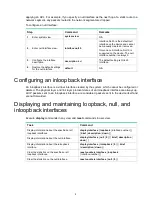
18
Step
Command
Remarks
polling interval.
3.
Enter Ethernet interface
view.
interface interface-type
interface-number
N/A
4.
(Optional.) Enable storm
control, and set the lower
and upper thresholds for
broadcast, multicast, or
unknown unicast traffic.
storm-constrain
{
broadcast
|
multicast
|
unicast
}
{
pps
|
kbps
|
ratio
}
upperlimit lowerlimit
By default, storm control is
disabled.
5.
Set the control action to take
when monitored traffic
exceeds the upper
threshold.
storm-constrain control
{
block
|
shutdown
}
By default, storm control is
disabled.
6.
(Optional.) Enable the
Ethernet interface to output
log messages when it
detects storm control
threshold events.
storm-constrain enable log
By default, the Ethernet interface
outputs log messages when
monitored traffic exceeds the
upper threshold or drops below
the lower threshold after
exceeding the upper threshold.
7.
(Optional.) Enable the
Ethernet interface to send
storm control threshold
event traps.
storm-constrain enable trap
By default, the Ethernet interface
sends traps when monitored
traffic exceeds the upper
threshold or drops below the
lower threshold from the upper
threshold after exceeding the
upper threshold.
Setting speed options for autonegotiation on an Ethernet
interface
About speed options for autonegotiation
By default, speed autonegotiation enables an Ethernet interface to negotiate with its peer for the
highest speed that both ends support. You can narrow down the speed option list for negotiation.
Figure 3 Speed autonegotiation application scenario
As shown in
IP network
Port D
Port A
Port B
Port C
Device
Sever 1
Sever 2
Sever 3






















